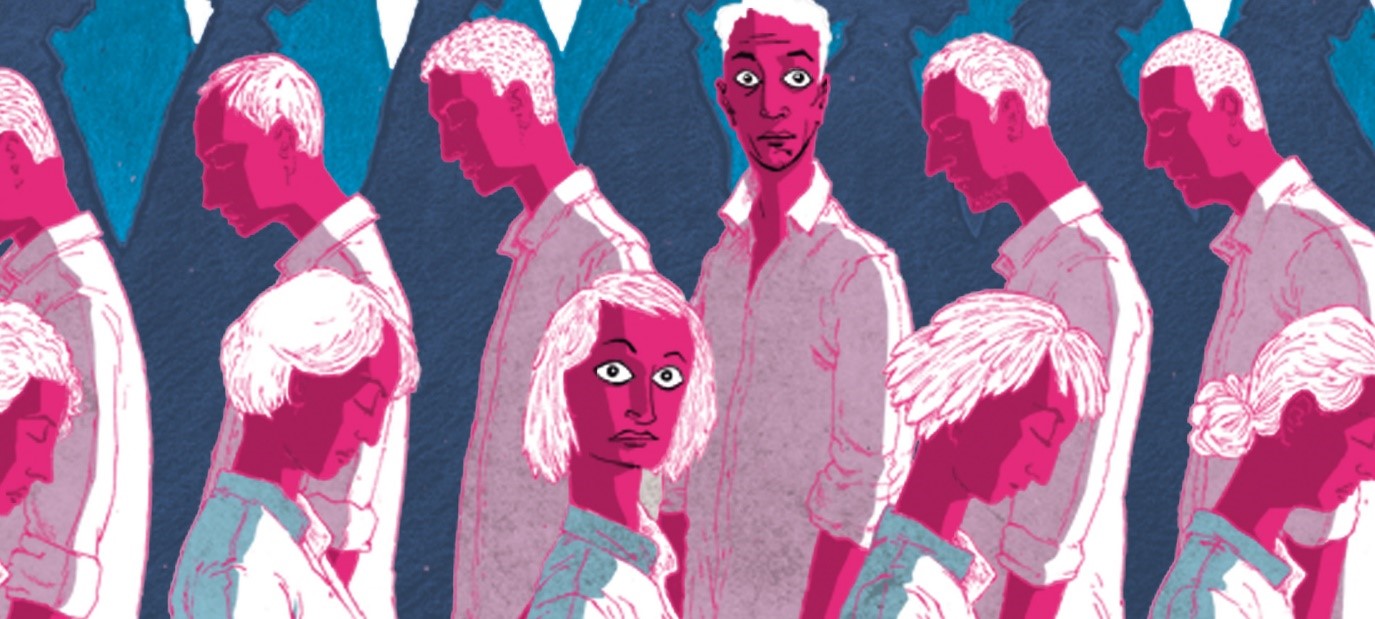The Guide, written by R K Narayan in 1958, celebrates the myriad mysteries and bizarre charms of India, as seen through the experiences of a small-town tour guide, Raju from Malgudi. The novel went on to be adapted on the silver screen and has been immortalised by Dev Anand and Waheeda Rehman, playing the protagonists Raju and Rosie respectively.
On R K Narayan’s 111th birth anniversary, here’s revisiting this timeless story that captures the crazy and magical spirit of India through its themes of love, loss, betrayal and the search for God.
Here’s an exclusive excerpt from the book.
RAJU WELCOMED THE intrusion—something to relieve the loneliness of the place. The man stood gazing reverentially on his face. Raju felt amused and embarrassed. ‘Sit down if you like,’ Raju said, to break the spell. The other accepted the suggestion with a grateful nod and went down the river steps to wash his feet and face, came up wiping himself dry with the end of a chequered yellow towel on his shoulder, and took his seat two steps below the granite slab on which Raju was sitting cross-legged as if it were a throne, beside an ancient shrine. The branches of the trees canopying the river course rustled and trembled with the agitation of birds and monkeys settling down for the night. Upstream beyond the hills the sun was setting. Raju waited for the other to say something. But he was too polite to open a conversation.
Raju asked, ‘Where are you from?’ dreading lest the other should turn round and ask the same question. The man replied, ‘I’m from Mangal.’
‘Where is Mangal?’
The other waved his arm, indicating a direction across the river, beyond the high steep bank. ‘Not far from here,’ he added. The man volunteered further information about himself. ‘My daughter lives nearby. I had gone to visit her; I am now on my way home. I left her after food. She insisted that I should stay on to dinner, but I refused. It’d have meant walking home at nearly midnight. I’m not afraid of anything, but why should we walk when we ought to be sleeping in bed?’
‘You are very sensible,’ Raju said.
They listened for a while to the chatter of monkeys, and the man added as an afterthought, ‘My daughter’s married to my own sister’s son, and so there is no problem. I often visit my sister and also my daughter; and so no one minds it.’
‘Why should anyone mind in any case if you visit a daughter?’ ‘It’s not considered proper form to pay too many visits to a son in-law,’ explained the villager.
Raju liked this rambling talk. He had been all alone in this place for over a day. It was good to hear the human voice again. After this the villager resumed the study of his face with intense respect. And Raju stroked his chin thoughtfully to make sure that an apostolic beard had not suddenly grown there. It was still smooth. He had had his last shave only two days before and paid for it with the hard-earned coins of his jail life.
Loquacious as usual and with the sharp blade scraping the soap, the barber had asked, ‘Coming out, I suppose?’ Raju rolled his eyes and remained silent. He felt irritated at the question, but did not like to show it with the fellow holding the knife. ‘Just coming out?’ repeated the barber obstinately.
Raju felt it would be no use being angry with such a man. Here he was in the presence of experience. He asked, ‘How do you know?’ ‘I have spent twenty years shaving people here. Didn’t you observe that this was the first shop as you left the jail gate? Half the trick is to have your business in the right place. But that raises other people’s jealousies!’ he said, waving off an army of jealous barbers. ‘Don’t you attend to the inmates?’ ‘Not until they come out. It is my brother’s son who is on duty there. I don’t want to compete with him and I don’t want to enter the jail gates every day.’

Tag: Author Birthday
5 Iconic Plays by George Bernard Shaw That Show Us Why He is the Master Playwright
Irish playwright, George Bernard Shaw, was born in Dublin on July 26, 1856. Beginning his career as a writer in London, Shaw wrote extensively in his initial years to make ends meet. After his novels failed repeatedly on being rejected by publishers, Shaw turned to writing plays.
As his plays went on to become huge successes, his satirical, witty style established him not only as a genius playwright, but also as a social commentator of his time. Shaw was also the first writer to win both the Nobel Prize for Literature in 1925 and the Academy Award for the Best Adapted Screenplay of his play, Pygmalion, in 1938.
Out of the 60 plays George Bernard Shaw wrote during his lifetime, here’s a glimpse at five of them one must not miss out on.
Pygmalion: G. B. Shaw’s most popular play, Pygmalion, premiered on stage on October 16, 1913. It is based on the well-known Greek mythological character by the same name. It has been adapted several times through the years not only on stage but also on screen, with My Fair Lady winning an Academy Award for best screenplay.

Saint Joan: G. B. Shaw’s play on the 15th century French ‘heroine’, Joan of Arc, premiered in 1923. After Joan of Arc was canonized by the Roman Catholic Church in 1920, Shaw studied the documents and transcripts of her life and trial to write a play, which he said, maintained his drama “at the level of high tragedy”.

Heartbreak House: Or Heartbreak House: A Fantasia in the Russian Manner on English Themes, was written in 1919 and premiered at the Garrick Theatre in UK’s Westminster in November 1920. In this play, Shaw adapts famous Russian writer, Anton Chekhov’s style to comment on society and the changing faces of people around us.

Candida: Written in 1894 and first published in 1898, Candida is a comedy that featured as a part of G. B. Shaw’s Plays Pleasant. The play that questioned the Victorian ideas of marriage, love and companionship became so popular that in 1904 the phenomenon was termed as “Candidamania”.

Man and Superman: The four act play written by Shaw in 1903 premiered on stage in May 1905. However, its first show omitted the third act of the play. Consequently, the third act — ‘Don Juan in Hell’, which is also the longest act in the play, has gone on to be performed as a separate piece by itself.
 Tell us your favourite work of George Bernard Shaw, as we celebrate the 161st birth anniversary of one of the pioneers of the Drama of Ideas.
Tell us your favourite work of George Bernard Shaw, as we celebrate the 161st birth anniversary of one of the pioneers of the Drama of Ideas.
The Fascinating Life of Ernest Hemingway: War-Veteran, Journalist, Wordsmith
Nobel laureate, Ernest Hemingway, was born on July 21, 1899 in Illinois, USA. With his works influencing generations of writers after him, Hemingway’s journalistic, pragmatic and prosaic approach became famous for conveying some of the most difficult subjects.
The evolution of Hemingway’s writing style has everything to do with the course his life had taken. For Whom the Bell Tolls and A Farewell to Arms talk about life during the times of war, a reality Hemingway had lived through for a major part of his life. But before Hemingway settled for a life as a writer, his tryst with other professions is what shaped him as the wordsmith that he is.
Here’s looking at Ernest Hemingway’s life through his different professions.
Life as an ambulance driver for the Red Cross: After graduating from high school, Hemingway turned eighteen and tried to enroll in the army as World Was I was raging in Europe. The United States had joined the fight against Germany and Austria in 1917. However, Hemingway did not make it to the army due to poor vision in one eye, something that had been passed down to him by his mother. But soon enough when he heard that the Red Cross was taking volunteers as ambulance drivers, he did not think twice before signing up. Soon after joining as an ambulance driver in Italy he was severely injured due to a mortar shell exploding a few feet away from him. Hemingway was consequently awarded the Italian Silver Medal for Valor for his services in war. A Farewell to Arms was inspired by this phase of Hemingway’s life.

Life as a journalist: Between graduating from high school and joining the Red Cross in Italy, Ernest Hemingway had his first tryst as a cub reporter for the Kansas City Star for six months. Later, after returning from war in January 1919, he had a difficult time coping with the tranquillity of life back home – a far cry from the adventurous days in the battlefield. Despite not having turned 20 yet, the war had made Hemingway mature by years in a matter of just a few months. He began to work as a staff writer and foreign correspondent for the Toronto Star Weekly later that year. In 1920, Hemingway moved to Chicago and continued to write for the weekly from there.
After his marriage, Hemingway moved to Paris in September 1921 on being hired as a foreign correspondent for the Toronto Star. In his first 20 months in Paris, he filed 88 stories for the newspaper. His years as a journalist overlapped with his years as a writer, as is often the case with many others.

Birth of the writer: Ernest Hemingway needs no introduction as a writer. He has won some of the most prestigious awards in the world of literature. Not only has he written works of fiction, like The Sun Also Rises, A Farewell to Arms, The Old Man and the Sea and For Whom the Bell Tolls, his works of non-fiction too, like Death in the Afternoon and Green Hills of Africa, have been widely read across the world through generations. Writers after his time have tried relentlessly to emulate his style that is crisp, sharp and prosaic, displaying a major hangover from his journalist days. Hemingway had become a spokesperson of World War I for his generation, thereby establishing his style distinctively from the other writers of his times.

Ernest Hemingway’s legacy lives on not only through his literature, but also through the millions of tributes made to him. From pens to planets, clothes to highway inns, Hemingway and his words have continued to live on, inspire, fascinate.
‘Toward an Impure Poetry’ by Pablo Neruda
Pablo Neruda was a Chilean Nobel Laureate, famous for his surrealist and passionate love poems, along with historical epics and political manifestos. He was regarded as the “the greatest poet of the 20th century in any language” by another South American Nobel Laureate Gabriel Garcia Marquez.
There have been two schools of thought regarding what poetry should stand for and who it should be written for. While one school says poetry should be for the elites, or it should be “pure”, the other school, that Pablo Neruda believed in, felt poetry should be “impure” or depicting the blunt realities of life. This belief of his can be observed throughout his body of work, using metaphors and imageries that are drawn from every day things.
Here is the essay he wrote on why poetry should be impure.
It is good, at certain hours of the day and night, to look closely at the world of objects at rest. Wheels that have crossed long, dusty distances with their mineral and vegetable burdens, sacks from the coal bins, barrels, and baskets, handles and hafts for the carpenter’s tool chest. From them flow the contacts of man with the earth, like a text for all troubled lyricists. The used surfaces of things, the wear that the hands give to things, the air, tragic at times, pathetic at others, of such things—all lend a curious attractiveness to the reality of the world that should not be underprized.
In them one sees the confused impurity of the human condition, the massing of things, the use and disuse of substance, footprints and fingerprints, the abiding presence of the human engulfing all artifacts, inside and out.
Let that be the poetry we search for: worn with the hand’s obligations, as by acids, steeped in sweat and in smoke, smelling of the lilies and urine, spattered diversely by the trades that we live by, inside the law or beyond it.
A poetry impure as the clothing we wear, or our bodies, soup-stained, soiled with our shameful behavior, our wrinkles and vigils and dreams, observations and prophecies, declarations of loathing and love, idylls and beasts, the shocks of encounter, political loyalties, denials and doubts, affirmations and taxes.
The holy canons of madrigal, the mandates of touch, smell, taste, sight, hearing, the passion for justice, sexual desire, the sea sounding—willfully rejecting and accepting nothing: the deep penetraion of things in the transports of love, a consummate poetry soiled by the pigeon’s claw, ice-marked and tooh-marked, bitten delicately with our sweatdrops and usage, perhaps. Till the instrument so restlessly played yields us the comfort of its surfaces, and the woods show the knottiest suavities shaped by the pride of the tool. Blossom and water and wheat kernel share one precious consistency: the sumptuous appeal of the tactile.
Let no one forget them. Melancholy, old mawkishness impure and unflawed, fruits of a fabulous species lost to the memory, cast away in a frenzy’s abandonment—moonlight, the swan in the gathering darkness, all hackneyed endearments: surely that is the poet’s concern, essential and absolute.
Those who shun the “bad taste” of things will fall flat on the ice.
Kafka on Screen: 5 Must-Watch Films Inspired by the Stories of Franz Kafka
Literary legend, Franz Kafka, has left generations of readers astounded with his fantastical stories, a style that has received its own special name – ‘Kafkaesque’. Alienation, existentialism, absurdity, all of it comes together in Kafka’s works to form a heady, surreal cocktail of words and imageries.
Several filmmakers have been inspired by Kafka’s stories, thereby creating some of the most visually stunning and eccentric works of cinema known to the world. Here are five outstanding adaptations of Kafka’s works one must watch:
The Trial (1962)

Based on Franz Kafka’s novel of the same name, this 1962 film by director Orson Welles follows the story of a bureaucrat who is arrested and persecuted for a crime that is neither mentioned to the protagonist nor to the viewer. Not only is the film the filmmaker’s personal favourite, but over the years has also been touted as a cinematic masterpiece by critics.
Franz Kafka’s It’s a Wonderful Life (1993)

Peter Capaldi’s Academy award winning short-film, Franz Kafka’s It’s a Wonderful Life, begins where writer Kafka started his deliciously dark tale of a man’s metamorphosis into an insect — on a piece of paper. The film explores the frustration of a writer confronting a creative block, as interruptions from the world around keep pouring in, only to make him wonder what it is that his protagonist transforms into when he wakes up. A banana? A kangaroo?
Franz Kafka’s A Country Doctor (2007)

Multiple award-winning anime short-film, Koji Yamamura’s Franz Kafka’s A Country Doctor, is an interpretation of Kafka’s short story by the same name. A bizarre chain of events unfolds when a country doctor visits a young patient in the middle of the night. Strange, unearthly horses, distorted houses and people, a young boy who oscillates between death and the will to die, Yamamura’s beautifully dark visuals married to Kafka’s haunting story leaves the audience questioning and wanting more.
The Metamorphosis of Mr. Samsa (1978)

What can be better than to watch your favourite story come alive in animation? The Metamorphosis of Mr. Samsa by Caroline Leaf is an animated short-film, using beach sand on a piece of glass. Fluid, shadowy images capturing the nightmarish nature of the original story, Leaf’s film is a stunning visual rendition of the most renowned work of Franz Kafka.
Watermelon Man (1970)

Melvin Van-Peeble’s classic, Watermelon Man, is based on the premise of Franz Kafka’s Metamorphosis. When ‘white insurance salesman’, Jeff Berger, wakes up to find himself in a black man’s body, (much like Kafka’s Gregor Samsa finds himself in a beetle’s body when he wakes up) all hell breaks loose as he initially tries to scrub off his dark skin in many creative ways. After finally accepting his reality of having transformed into a black man, Berger ironically finds himself in situations which he looked down upon as a man of white descent.
Tell us which ‘Kafkaeqsue’ film is your favourite.
6 Themes of George Orwell’s ‘1984’ that We Need to be Mindful of
George Orwell’s dystopian masterpiece, Nineteen Eighty-Four, is perhaps the most pervasively influential book of the twentieth century, and here are a few important themes of the book that we need to be mindful of.
Totalitarianism: Total Control, Pure Power
The Party – the controller of the superstate – “seeks power entirely for its own sake.” As an official admits: “We are not interested in the good of others; we are interested solely in power, pure power.”

Propaganda Machines
A well-organized and effective propaganda machine goes a long way in ensuring total control of the Party over the superstate and its residents. The regulation and dissemination of information involves “tearing human minds to pieces and putting them together again in new shapes of your choosing.”

The Thing Called Love
The totalitarian knows that to rule people he needs to quell all ways of achieving happiness and fulfilment. Therefore, love and sex, two of the most enriching human experiences, are killed and depersonalized.

Liberty and Censorship
The Ministry of Truth works tirelessly and meticulously to modify public archives and rewrite history. As a result, “the past was erased, the erasure was forgotten, the lie became the truth.”

Language: Doublethink and Newspeak
The residents of the superstate are forced to communicate in Newspeak – the government’s invented language. It plays a pertinent role in the Party’s control over the masses.

Technology: All-seeing Telescreens and a Watchful Eye
The Party needs and develops top-notch technology to exercise ruthless control over the residents. Without telescreens, the Thought Police would fail in its objective of surveillance. And, of course, overseeing all of this is Big Brother.

Gripped by the themes above? Are you going to read or reread Nineteen Eighty-Four? Do tell us about other ominous themes of the book that all of us should be mindful of!












